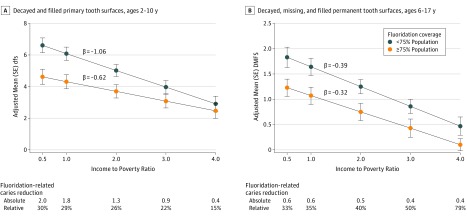Figure. Predicted Covariate-Adjusted Number of Tooth Surfaces Affected by Dental Caries in the Primary and Permanent Dentitions (National Health and Nutrition Examination Surveys 1999-2004, 2011-2014), Stratified by County Population Coverage of Fluoridated Community Drinking Water.
Decayed and filled primary tooth surfaces in children aged 2 to 10 years (A) and decayed, missing, and filled permanent tooth surfaces in those aged 6 to 17 years (B). The values on the x-axis were selected to represent income to poverty ratio. Living in a predominantly fluoridated county reduced the magnitude of income inequalities in dental caries. This attenuation was statistically significant in the primary dentition (P value for interaction of .03) but failed to reach significance in the permanent dentition of those aged 6 to 17 years (P value for interaction, .49). Values were adjusted for sex, age, race/ethnicity, urban rural classification, and time since last dental visit. Tables below plots report mean fluoridation-related caries reductions as absolute differences (adjusted mean caries for <75% population coverage group minus ≥75% population coverage group) and relative differences (absolute difference divided by adjusted mean caries for <75% population coverage group) for selected values of income to poverty ratio. Data given below the plots report mean fluoridation-related caries reductions as absolute differences (adjusted mean caries for <75% population coverage group minus ≥75% population coverage group) and relative differences (absolute difference divided by adjusted mean caries for <75% population coverage group) for selected values of income to poverty ratio.

